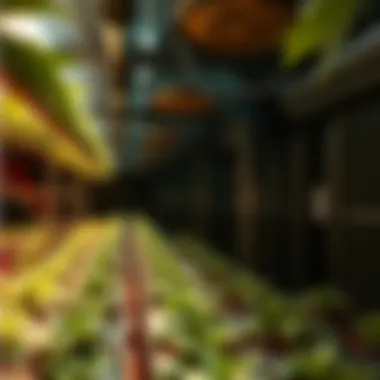Exploring Hydroponic Chambers: A Comprehensive Overview


Intro
The world of agriculture stands at the brink of a significant transformation as it embraces innovative technologies for sustainable farming. Among these advancements, hydroponic systems emerge as a critical solution for addressing the challenges of land scarcity and the need for efficient resource use. This article takes an in-depth look into hydroponic chambers, examining not just their design and functionalities, but also the broader implications they hold for modern agricultural practices.
Hydroponic systems enable plants to flourish without soil, using nutrient-rich water as a substitute. The potential for growing food in urban spaces and regions with poor soil conditions opens up a realm of possibilities for increased food production. Before we leap into the details of these systems, it’s essential to establish a foundational understanding.
Key Concepts and Terminology
Definition of Terms
To grasp the intricacies of hydroponic chambers, we must first familiarize ourselves with some key terms and concepts:
- Hydroponics: A method of growing plants without soil, where the roots are immersed in a nutrient-laden solution.
- Aeroponics: A variation of hydroponics, involving the spraying of nutrient solution onto the roots suspended in the air.
- Nutrient Film Technique (NFT): A type of hydroponic system where a thin film of nutrient solution cleverly flows over the roots.
- Deep Water Culture (DWC): A system where plants are suspended in water while an air pump supplies oxygen to the roots.
Overview of Relevant Practices
Hydroponic systems are classified into several types, each suited to different applications:
- Ebb and Flow Systems: These involve flooding the grow bed with nutrient solution before draining it, providing the plants with the necessary nutrients and oxygen.
- Wick Systems: A simple approach where a wick draws the nutrient solution from a reservoir to the plant roots, making it a favored choice for beginners.
- Drip Systems: Utilizing a drip emitter, these systems deliver nutrient solution directly to the base of each plant, allowing for precise control over watering.
Understanding these concepts equips farmers and enthusiasts with the knowledge needed to navigate the unique characteristics and advantages of various hydroponic systems. With the basics in place, we can uncover the latest trends and innovations shaping this fascinating field.
Prologue to Hydroponics
In recent years, hydroponics has emerged as a revolutionary approach to agriculture, changing the way we think about growing plants. This method, which eliminates soil use and relies on nutrient solutions to nourish plants, has paved the way for innovative techniques that promise increased productivity and sustainable practices. The importance of hydroponics lies not merely in its ability to facilitate plant growth but also in its capacity to address some of the pressing challenges of modern agriculture.
For example, with the rising global population, traditional farming methods may struggle to meet the increasing food demand. Hydroponics offers solutions that can operate in limited space and under various environmental conditions, making it a viable option for urban settings and areas with poor soil quality. Moreover, it requires significantly less water than conventional agriculture, an essential consideration as water scarcity becomes an ever-growing concern.
Another critical aspect of hydroponics is the ability to control the growing environment. By managing factors such as nutrient delivery, light exposure, and humidity, farmers can optimize plant growth and produce consistent yields year-round, regardless of seasonal changes.
Why Focus on Hydroponics?
- Soil-less Cultivation: Enables plant growth in areas where traditional soil is not available or usable.
- Water Conservation: Utilizes up to 90% less water compared to traditional farming.
- Space Efficiency: Allows vertical farming and maximizes limited growing areas, especially in urban centers.
- Pest and Disease Management: Reduces the risk of soil-borne pests and diseases, leading to lower pesticide use.
"Hydroponics is not just about growing plants; it's about rethinking the future of food production."
Engaging with hydroponics opens doors to new agricultural opportunities. This article seeks to unravel the intricacies of hydroponic chambers, detail their design, functionality, and significance, and explore the implications this method has for the future of agriculture.
Understanding Hydroponic Chambers
Understanding hydroponic chambers is crucial as these systems represent a significant evolution in agricultural practices. They enable farmers and enthusiasts alike to cultivate plants without soil, offering advantages in terms of resource efficiency and crop yield. The importance of this topic cannot be overstated, especially in today's world, where space is limited and sustainability is on everyone’s minds.
Hydroponic chambers are specialized systems designed to provide the ideal environment for plant growth, offering precise control over nutrients, light, and climate. By thoroughly grasping the mechanics of these chambers, users can optimize plant growth and ensure their agricultural practices are not only productive but also sustainable.
What is a Hydroponic Chamber?
A hydroponic chamber is essentially a controlled environment designed for growing plants without soil. These chambers can vary widely in size and complexity; they may range from simple setups, like small DIY systems utilizing plastic containers, to advanced systems incorporating high-tech sensors and automation.
At its core, a hydroponic chamber utilizes nutrient-rich water solutions to feed the plants directly through their roots. Plants can thrive in this solution because it gives them access to the essential nutrients they need for growth, while water management becomes critically important. This means that precise measurements of nutrient concentrations and pH levels must be consistently maintained to support optimal growth.
What sets hydroponic chambers apart from traditional farming methods is
- the speed of plant growth
- the reduction of water usage
- the flexibility in crop placement, among various other factors.
Importance in Modern Agriculture
The role of hydroponic chambers in modern agriculture cannot be ignored. They offer various benefits that can address some significant challenges faced by traditional farming. One of the most pressing issues is resource scarcity—water being one of the most vital yet limited resources in farming.
Here are several key advantages:
- Water Efficiency: Hydroponic systems utilize up to 90% less water than conventional farming, making them particularly valuable in arid or water-scarce regions.
- Space Maximization: By allowing vertical farming and stacking plants, these systems can yield more produce per square foot compared to traditional methods.
- Reduced Pest Pressure: With the absence of soil, many pests that commonly attack soil-grown crops are minimized, leading to fewer pesticide applications and a generally healthier crop yield.
- Year-Round Production: Hydroponic systems can support consistent crop growth throughout the year, irrespective of weather conditions.
By leveraging these benefits, hydroponic chambers not only contribute to food security but also offer a more environmentally friendly alternative to traditional farming. As urbanization increases and arable land diminishes, understanding the importance and functionality of hydroponic chambers becomes imperative for future agricultural practices.
"In urban farming, hydroponic systems hold the key to producing food in confined spaces, making them a crucial element in addressing the global food crisis."
For further reading on hydroponics and its implications, consider exploring the resources available on sites such as Wikipedia and Britannica. Additionally, community forums like Reddit provide valuable insights and experiences from fellow enthusiasts and farmers.
Types of Hydroponic Chambers


Understanding different types of hydroponic chambers is essential for anyone looking to embrace soil-less agriculture, whether you're seasoned in the field or just dipping your toes into the water. Each type of chamber serves a unique purpose in the hydroponic ecosystem, tailored for specific plant needs and growth conditions. The varying designs and functions can significantly impact plant health, yield, and efficiency – factors critical in modern agriculture.
Nutrient Film Technique (NFT) Chambers
The Nutrient Film Technique, often shortened to NFT, represents a hydroculture method that leverages a thin film of nutrient-rich water. In an NFT chamber, plant roots dangle into a sloped channel containing this nutrient film. It’s a real dance of delicate balance—always keeping roots moist but not submerged.
Benefits of NFT Chambers:
- Efficiency: Water and nutrients are recycled continuously, leading to less waste and reduced water usage.
- Aeration: The constant flow allows for good oxygen exposure, crucial for root health.
- Space-saving: Ideal for vertical farming, maximizing every square foot available.
While NFT chambers offer many advantages, they also come with considerations. For instance, any interruption in the flow can lead to rapid root death due to lack of moisture. Farmers must monitor systems closely, but when conditions are right, the reward can be bountiful.
Deep Water Culture (DWC) Chambers
DWC chambers bring a different flavor to hydroponic farming, especially with its straightforward approach that almost speaks to simplicity itself. In a DWC system, plant roots are suspended in a nutrient solution while an air pump provides oxygen. Imagine having a feast ready for your plants!
Benefits of DWC Chambers:
- Rapid Growth: With oxygen-rich nutrient solutions, plants experience accelerated growth.
- Simplicity: Easy to set up, which makes it suitable for beginners who appreciate clear processes.
- Resilience: The large volume of water models a buffer from temperature variations, aiding stability and nutrient supply.
However, the straightforward nature of DWC does not forestall challenges. With this method, a power outage can leave plants gasping for breath. Hence, backup systems and checks are vital to keep everything flowing smoothly.
Aeroponic Chambers
Aeroponic chambers bring high-tech methods to the game, using mist or aerosolized nutrient solutions. This method gives plants both air and water right at the root zone and encourages a truly high-efficiency growth practice. Roots dangle in the air, entirely suspended, while a mist periodically provides necessary nutrients. This can feel like gardening in a science fiction movie!
Benefits of Aeroponic Chambers:
- Maximum Oxygen Exposure: Roots are fully aerated, promoting faster growth and healthier plants.
- Water Conservation: Uses significantly less water than traditional hydroponics due to the misting method.
- Pest Control: With no soil to harbor pests, you're one step ahead in pest management.
Yet, the wonders of aeroponics don’t come without their pitfalls. Because the system relies heavily on multiple pumps and timers, regular maintenance is crucial to avoid catastrophic failures. A mist failure in aeroponics can lead to serious issues before you realize something's amiss.
The essence of hydroponic chambers is not just about the technology but understanding how each system nourishes our plants with precision and care.
In summary, hydroponic chambers vary widely, catering to different growth strategies and environmental conditions. Recognizing the strengths and weaknesses of each type helps farmers and gardeners make informed decisions, leading to bountiful harvests and effective resource management.
For more comprehensive insights into hydroponics, consider visiting the following links:
Understanding the types of hydroponic chambers is a stepping stone towards cultivating success in modern agricultural practices. As the interest in hydroponics expands, so do opportunities for innovation and growth within the field.
Components of a Hydroponic Chamber
In the realm of hydroponics, the components of a hydroponic chamber are nothing short of foundational. It's like building a house; each part plays a specific role, and when one element falters, the whole system can be affected. With this in mind, let's take a closer look at the key pieces that make up these innovative growing environments.
Reservoir Systems
A hydroponic chamber's reservoir system serves as the lifeblood of the operation. This is where nutrient-rich water is stored and made available to the plants. Think of it as a cafeteria that provides nourishment in the most efficient manner possible. Without a well-designed reservoir system, you could be left with either over-saturation or drought, both of which are detrimental to plant health.
It's essential to maintain the right balance of water and nutrients. This typically involves regular monitoring of the electric conductivity (EC) and pH levels, ensuring that the plants' roots receive the food they need without encountering toxic build-ups.
- Materials: Most reservoirs are made of food-grade plastic or metal, ensuring safety and durability.
- Size and Shape: Depending on the crop size and system type, the dimensions of the reservoir can vary significantly.
- Accessibility: A well-placed reservoir allows for ease in refilling and monitoring.
These factors collectively contribute to a robust reservoir system, ultimately leading to more vigorous plant growth.
Lighting Solutions
Next up are lighting solutions, pivotal for mimicking the sun's rays. In a hydroponic chamber, light is a non-negotiable asset, as it directly influences photosynthesis, the process through which plants convert light energy into chemical energy. Think of it as flipping on the switch in a dark room; it transforms what's possible.
Most contemporary hydroponic systems lean towards LED lights due to their efficiency and low heat output. These lights can be customized for spectrum quality, producing just the right wavelengths for different stages of growth, from seedling to fruit-bearing. Here's what needs to be considered:
- Light Intensity: This must be tailored to suit the plant species and growth stage.
- Duration: Hours of light, commonly referred to in terms of photoperiod, should align with natural growth patterns.
- Height Adjustment: Keeping lights at the optimal distance ensures plants get enough light without suffering from burn.
Proper lighting not only boosts productivity but also can improve the flavor and nutritional value of the crops.
Environmental Control Systems
Finally, we come to environmental control systems, which oversee the overall conditions within the hydroponic chamber. These systems help control climate variables such as temperature, humidity, and airflow. Imagine trying to sleep with your room too hot or too cold – plants are no different.
The ideal environment will vary depending on the specific plants being cultivated, but generally, a temperature range of 70-75°F is favorable. Here are some critical elements to consider:


- Temperature Control: Utilizing heaters or air conditioning units to maintain the desired heat levels.
- Humidity Control: Devices like dehumidifiers or humidifiers can help keep moisture levels in check.
- Airflow: Proper ventilation systems to ensure adequate movement of air, preventing mold and improving growth.
An efficient environmental control system helps in maintaining consistent growth rates and minimizing plant stress, crucial for any hydroponic cultivator aiming for success.
In summary, the components of a hydroponic chamber work synergistically, akin to a well-orchestrated symphony. Each plays its role, and when they harmonize, the results can be nothing short of extraordinary.
Hydroponic Nutrients and Solutions
In the realm of hydroponics, understanding nutrients is akin to knowing a composer’s symphony—each note has its purpose. Hydroponic systems, which allow plants to grow without soil, rely heavily on nutrient solutions to ensure plants thrive. This section highlights the pivotal role of hydroponic nutrients and their various dynamics, which are critical for anyone delving into this advanced agricultural methodology.
Essential Nutrients for Plant Growth
Every plant, no matter how grand or small, thrives on a specific suite of nutrients. These can be broken down into macronutrients and micronutrients. Macronutrients are the big hitters that plants need in large quantities, including:
- Nitrogen (N): The building block of amino acids; vital for leafy growth.
- Phosphorus (P): Crucial for energy transfer and photosynthesis; supports root development.
- Potassium (K): Helps in regulating stomatal opening, maintaining water balance, and promoting fruit development.
However, micronutrients also play a massive role, even if they are required in smaller amounts. Elements such as iron, manganese, zinc, and copper are essential—they support various physiological functions and enzymatic processes. A deficiency in these micronutrients can lead to significant growth issues, showing the delicate balance that must be struck within these nutrient solutions.
"The right balance of nutrients is like the perfect recipe; too much or too little can spoil the whole dish."
pH and EC Management
Equally important to nutrient formulation is managing the pH and electrical conductivity (EC) of the nutrient solution. These factors can have a profound effect on nutrient availability.
- pH: This measures how acidic or alkaline the solution is. Most plants in hydroponic settings prefer a pH range between 5.5 and 6.5. If the pH strays too far, certain nutrients become locked out—meaning plants can’t absorb them. Think of it as tuning a guitar; if it’s off, the music just doesn’t sound right.
- Electrical Conductivity (EC): This measures the concentration of dissolved salts in the solution, which reflects the nutrients available to your plants. Maintaining the correct EC is crucial; if it's too high, it can lead to nutrient burn, while too low can starve the plants. Regular monitoring with an EC meter is standard practice.
Balancing these two elements may seem daunting, but it’s crucial for the health of plants in hydroponic chambers. Cultivators might keep pH adjustment solutions on hand, and some more intricate setups employ automated pH controllers to simplify the process.
Overall, understanding hydroponic nutrients and their management lays the groundwork for successful plant cultivation. It’s not just about the quantity of nutrients, but about tailoring the right mix and maintaining optimal conditions throughout the growth cycle.
For further reading on hydroponic practices and nutrient management, consider visiting Wikipedia on Hydroponics or exploring educational resources like Britannica.
Plant Growth Dynamics in Hydroponic Chambers
Understanding how plants grow in hydroponic environments is crucial. This section highlights the intricate dynamics of plant growth processes and emphasizes the significant advantages offered by hydroponic systems. It’s not just about growing plants without soil; it’s about creating optimal conditions that enhance growth rates, improve nutrient uptake, and ultimately lead to healthier crops.
Photosynthesis and Light Quality
In a hydroponic setting, photosynthesis plays a pivotal role in plant health and productivity. Unlike traditional soil-based growing, which relies heavily on sunlight, hydroponic systems often utilize artificial lighting. This shift brings forth the challenge of ensuring that light quality is optimal for the photosynthetic process.
Plants require specific wavelengths for effective photosynthesis, predominantly in the blue and red spectrum. Therefore, using full-spectrum LED grow lights can emulate natural sunlight, allowing for maximum photosynthetic efficiency. These lights not only promote healthy foliage and blooming but also ensure that plants can effectively convert light into energy, leading to accelerated growth cycles.
"The quality of light can significantly influence plant morphology, growth rate, and yield."
The distance and duration of light exposure can also affect growth dynamics. For instance, too much light can lead to photoinhibition, where plants are unable to process the excess energy properly. Thus, careful monitoring of light conditions is essential for achieving the best possible growth outcomes. Adjusting light settings based on the growth stage of the plant can yield better results over time.
Root Development Under Hydroponic Conditions
Roots are the unsung heroes of hydroponics, acting as the main avenue for nutrient uptake. In a hydroponic system, roots are submerged in nutrient-dense water instead of being anchored in soil. This unique condition can accelerate root development, as they have immediate access to a balanced supply of water and nutrients.
However, it also poses certain considerations. Unlike soil which offers structural support, hydroponic roots must adapt to this aquatic environment. Maintaining the right balance of oxygen in the nutrient solution is vital. A lack of oxygen can lead to root rot and negatively impact plant health. Aeration techniques, such as air stones, can be employed to keep the roots well-aerated and thriving.
Moreover, root development plays a significant role in determining overall plant yield. When plants are healthy and their root systems are well established, they can uptake nutrients more effectively, translating into faster growth rates and higher yields. The interaction of roots with the nutrient solution in hydroponic systems emphasizes the delicate balance that must be maintained for maximum productivity.
Advantages of Hydroponic Chambers
In the realm of modern agriculture, hydroponic chambers stand out as game changers, revolutionizing the way crops are grown. Understanding the benefits they offer is crucial for both farmers using these systems and enthusiasts keen on soil-less gardening. Hydroponic systems boast several significant advantages that address some of the pressing challenges faced in conventional agriculture.
Water Efficiency
One of the hallmark advantages of hydroponic chambers is their exceptional water efficiency. Traditional soil-based farming often leads to substantial water wastage through evaporation and runoff. In contrast, hydroponic setups recirculate water, allowing plants to absorb only what they need. On average, hydroponic growing systems use up to 90% less water compared to traditional farming methods, making them crucial in areas facing water scarcity. The closed-loop nature minimizes waste, allowing for efficient nutrient delivery to the plants.
The ability to monitor and control water usage not only conserves vital resources but also enables farmers to grow crops even in arid regions. This efficiency not only satisfies environmental concerns but also reduces operational costs, creating a win-win situation for growers.
Maximized Space Utilization
Maximized space utilization is another essential benefit of hydroponic chambers. In urban settings where space for farming is limited, hydroponic systems enable the vertical growing of crops, effectively increasing yields in confined areas. Unlike traditional farming that relies on expansive fields, hydroponic systems allow crops to be stacked in layers, utilizing every inch of available space.
This vertical approach to farming is particularly beneficial for cities. By utilizing hydroponic chambers, it’s possible to transform rooftops and vacant lots into thriving gardens. As a result, urban dwellers can gain access to fresh produce, significantly reducing the transportation costs and carbon emissions associated with food delivery.


Reduced Pest and Disease Pressure
Hydroponic systems naturally offer reduced pest and disease pressure when compared to conventional agriculture. By eliminating the need for soil, which is often a breeding ground for pathogens, these systems significantly mitigate the risk of root diseases. The controlled environment of a hydroponic chamber restricts pests, providing a cleaner growing atmosphere.
Moreover, hydroponic farming typically employs integrated pest management techniques rather than chemical pesticides, promoting healthier crop production. This leads to higher quality produce without the worry of harmful residues, aligning with a growing consumer demand for organic and sustainably grown foods.
“With hydroponic chambers, growers can have a better grip on their crops’ health, minimizing risks that come from traditional farming methods.”
While challenges persist, the advantages of hydroponic chambers are compelling enough for many farmers and enthusiasts to dive deeper into this innovative approach to agriculture. As society progresses towards sustainability and efficiency, the role of hydroponic systems is bound to expand, paving the way for a resilient agricultural future.
Challenges in Operating Hydroponic Chambers
Operating hydroponic chambers comes with its own set of hurdles that can be the difference between a flourishing output and a failed venture. While these systems present a treasure trove of possibilities for modern agriculture, the challenges inherent within their operation merit significant attention. Understanding these issues is crucial for any farmers or enthusiasts diving into the world of hydroponics. It aids in developing informed protocols, refining management techniques, and ensuring sustainability in practices.
Technical Complexity
Hydroponic systems can be intricate, often resembling a high-tech puzzle that needs to be pieced together with precision. The intricacy begins with the design — from nutrient delivery systems to lighting and climate control mechanisms, every component must work in harmony. If one part falters, the entire system may suffer.
The importance of technical know-how cannot be overstated. Farmers stepping into this domain often face a steep learning curve. New users may struggle with understanding nutrient mixing ratios or managing pH levels, which are crucial for plant health. Moreover, using features like sensors and automated systems can be daunting if one lacks an understanding of these technologies.
The various hydroponic techniques themselves — whether it’s Nutrient Film Technique or Deep Water Culture — each have a unique set of requirements. Such diversity in setups can lead to confusion for those just starting. Thus, it’s essential for newcomers to not only invest time in learning but also consider ongoing support and guidance from seasoned hydroponics practitioners or reliable resources on forums like Reddit.
Initial Investment Costs
Setting up a hydroponic chamber demands a significant initial financial outlay. Unlike traditional soil farming which might allow entry with minimal tools, hydroponic gardening typically requires specialized equipment, including water pumps, reservoirs, grow lights, and nutrient solutions. The price can soar depending on the scale of the operation and the sophistication of the systems chosen.
For small-scale operations, budget-friendly options are often available. However, opting for these might mean sacrificing some efficiency and functionality.
In light of this, potential hydroponic farmers must conduct thorough assessments of their budget and financing options. Some may find grants or subsidies through agricultural programs or future trends asserted by institutions like USDA, yet navigating these financial waters can prove equally vexing.
To supplement knowledge, consider the following:
- Research affordable suppliers for equipment and materials.
- Explore second-hand market avenues to cut down initial costs.
- Seek advice on optimizing the usage of existing resources before going all in.
Sustainability and Hydroponic Chambers
Sustainability is key in agriculture, as it ensures that farming practices can meet the needs of today without compromising the ability of future generations to meet their own needs. In-depth examination of sustainability in the context of hydroponic chambers highlights their role as a viable alternative to traditional soil-based farming. Hydroponic systems are designed to optimize resource usage, making them particularly relevant in our changing environmental landscape.
Environmental Impact Considerations
Hydroponic chambers present a lower environmental footprint compared to conventional farming methods. Since these systems use nutrient-rich water instead of soil, they can significantly reduce the amount of water needed for cultivation. This is crucial in drought-prone areas.
- Water Use Efficiency: Hydroponics can use up to 90% less water than traditional methods. This efficiency stems from recycling water within the system, rather than letting it seep into the ground or evaporate.
- Reduced Land Requirements: By allowing for vertical farming and crop stacking in limited spaces, hydroponic farming can thrive in urban areas without requiring large tracts of land.
- Fewer Pesticides and Herbicides: The controlled environments of hydroponic chambers can minimize pest access, often leading to less reliance on chemical treatments. This is a plus for the local ecosystems nearby and can result in healthier produce for consumers.
"Hydroponics isn't just a method to grow plants; it's an evolution in how we may cultivate food sustainably."
In terms of emissions, hydroponic systems often utilize renewable energy sources to power their lighting and climate controls, further reducing their carbon footprint. Nevertheless, every technology comes with its challenges. The production of equipment and maintaining optimal conditions still demand energy, making continuous improvements in sustainability practices a pressing need for the industry.
Future Trends in Hydroponics
Looking ahead, the future of hydroponics is set to be shaped by advancing technologies and innovative practices that cater to sustainable farming. Key trends to watch include:
- Integration of IoT Technologies: The rise of smart farming tools that include sensors and automation has the potential to revolutionize hydroponic practices. By monitoring water levels, nutrient concentrations, and environmental conditions in real-time, farmers can optimize growth cycles and reduce wasted resources.
- Increasing Use of Renewable Energy: More hydroponic farms are likely to integrate solar panels and wind energy systems into their setup, leading to completely self-sustaining farms capable of running independently from conventional energy sources.
- Vertical Farming Expansion: As urban spaces become busier, vertical farming is expected to grow. By setting up hydroponic chambers in warehouses or rooftops, cities can produce food locally, reducing transportation emissions and increasing food security.
Moreover, there’s a rising interest in developing new crops that thrive in hydroponic conditions, broadening the potential of these systems. It’s an exciting time for hydroponics, as the collective movement towards sustainability gains traction, making it a crucial aspect of modern agriculture.
For those interested in deeper dives into the science and data behind hydroponics, resources can be found at Wikipedia and Britannica.
In summary, addressing sustainability through hydroponics not only aligns with global needs but also enhances economic viability for farmers. These chambers are not just a temporary trend; they signify a pivotal shift towards more responsible and efficient farming practices.
Finale
In this article, we've taken a thorough journey through the multifaceted world of hydroponic chambers. This section aims to highlight the pivotal elements we discussed throughout the text, underscoring the benefits, challenges, and future prospects in hydroponics. Understanding hydroponic chambers is not just for the experts; it is crucial for anyone interested in modern farming techniques. Their function is not simply eliminating soil from the growth process, but rather optimizing conditions that lead to healthier, faster-growing plants.
Summarizing Key Takeaways
- Hydroponics Defined: We started by defining hydroponics and examining its historical roots, setting the stage for understanding how these systems evolved.
- Chamber Varieties: Each type of hydroponic chamber, from Nutrient Film Technique to Deep Water Culture, offers unique strengths tailored for different crops and cultivation methods.
- Key Components: The importance of precise environmental controls, adequate lighting, and nutrient management cannot be overstated. Each factor plays a significant role in the overall productivity of the system.
- Advantages: The water efficiency and space maximization of hydroponic systems are compelling reasons for their increasing adoption, especially in urban and resource-limited environments.
- Challenges: We also tackled the challenges inherent in hydroponic systems, like the technical complexity and upfront costs, which are crucial considerations for potential farmers and enthusiasts.
- Sustainability Discussion: We explored the environmental impact and future trends that indicate hydroponics is not just a passing fancy but a key component in sustainable agriculture.
This encapsulation serves as a reminder of the immense potential and ongoing evolution of hydroponic technologies.
Future Directions in Hydroponic Practices
As we look forward, the future of hydroponic practices appears promising but requires careful consideration of several factors. Advances in technology, particularly automation and data analytics, are set to enhance the efficiency and scalability of hydroponic systems. Here's what might lie ahead:
- Smart Hydroponic Solutions: The integration of Internet of Things (IoT) devices and artificial intelligence could lead to systems that can monitor and adjust conditions autonomously, making hydroponic farming more accessible and efficient.
- Biological Innovations: Research into plant biology will likely yield new nutrient formulations and seed varieties optimized for hydroponic growth.
- Sustainable Practices: As climate concerns escalate, the focus on sustainability practices such as the use of renewable energy sources within hydroponic chambers may become a norm rather than an exception.
- Community Engagement: Educating communities about the effectiveness and benefits of hydroponic systems can foster grassroots movements that encourage local food production, expanding the reach of these technologies.
In summary, hydroponic chambers present a valuable opportunity for resourceful farming that is poised for growth. Continually evolving technology combined with an increasing focus on sustainability means that hydroponics is a field worth watching.







